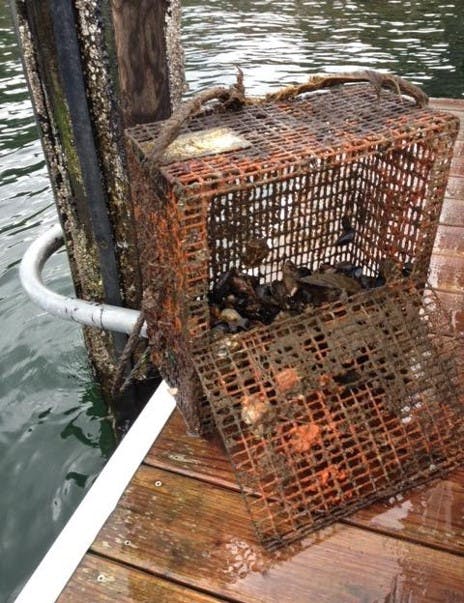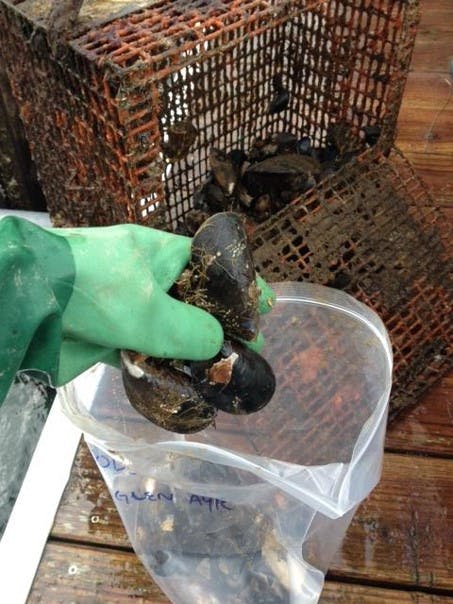County and state health departments, Lummi Tribe and others monitor local waters to protect shellfish eaters from paralytic shellfish poisoning

Lummi Tribe members are working with Washington state health and environmental supervisors to ensure Whatcom residents don’t eat poisonous shellfish.
Paralytic Shellfish Poison, known as PSP, is a biotoxin — a poison produced by a living organism — that can cause illness and death, according to a Whatcom County press release. The county reported on June 18 that the levels detected in county mussels had become unusual, concerning and possibly deadly.
Jerry Borchert, marine biotoxin and shellfish licensing and certification expert with the Washington State Department of Health, said beach closures for the biotoxin started in the spring and the state is still dealing with PSP — especially in Whatcom County.
Tom Kunesh, the environmental health supervisor for the Whatcom County Health Department, said all county beaches are closed to the harvest of all molluscan shellfish because of elevated biotoxin levels. This includes clams, mussels, oysters and scallops.
Those levels have been decreasing the last few weeks, Kunesh said, but the department doesn’t have enough information to open the beaches yet.
“There’s no health hazard to visit the beach, to wade in the water, to put your floatie devices in and recreate with your kayaks, your innertubes, your whatever,” he said. “All of that is perfectly safe.”
Kunesh said the health department uses mussels as a sentinel species, meaning they are the first species to pick up PSP when the plankton carrying it are prevalent in the water, and they can signal to the department whether the toxin is in local shellfish. He said the mussels are also the first to purge the toxin after a bloom — a rapid plankton reproduction that could cause illness — in the water has dissipated.
The department samples mussels every other week, which becomes weekly if any toxin is detected in any of the samples, he said.
Borchert said the Washington State Department of Health just had its first good testing result — under 80 micrograms of toxin per 100 grams of shellfish — in Birch Bay since the biotoxin closures started.
Kunesh said there may be toxin in the water, but not at levels that would hurt anybody.

“Molluscan shellfish are filter feeders,” he said. “Throughout the course of a day, they will filter gallons and gallons and gallons of seawater and concentrate the plankton that carry the toxin. And that’s why the shellfish become toxic.”
Kunesh said many partners help the department with their effort to protect the public from toxic shellfish — homeowners’ associations, government agencies like parks departments, Port Authority, and the Lummi Nation.
“Lummi Nation is a great partner for us,” he said. “Port Authority helps us post signs in port property state parks.”
Kunesh explained that commercial shellfish operations are tightly regulated, and shellfish growers, harvesters and shippers have to be licensed by the Washington State Department of Health. Before moving products to market, they are tested to make sure they aren’t contaminated with biotoxins. He said this means shellfish at stores and restaurants are safe to eat.
Bill Dewey, director of public affairs for Taylor Shellfish Company whose Samish Bay location is on Chuckanut Drive, said the Washington State Department of Health posts the results of testing shellfish samples for PSP in a biotoxin index.
“You can see samples that you’ve submitted and you can see samples that every other company has submitted, and volunteers are submitting from recreational beaches. So you kind of get a feel for what’s going on,” he said.
Dewey said this website helped his company decide where to conduct their own sampling. He’d just checked it and noticed mussel samples with high biotoxin activity.
“That tells me that there’s some activity just north of us in Samish Bay, so I’ll call that to the attention of our managers to make sure we get some samples,” he said.
It is easier for commercial harvest operations to get enough shellfish supply during marine closures than for smaller or recreational harvest operations, Dewey said. The ability to routinely send samples for PSP testing is included in their state department of health license fees.
For recreational harvest, done by any resident who goes to county beaches for shellfish, the health department can’t test all beaches for biotoxins and errs on the side of shutting them down to protect residents who don’t conduct their own testing.
“For their commercial fisheries, commercial industry, we’re sending samples on a routine basis so we’re able to track it pretty carefully,” he said. “Make sure we’re not selling any shellfish that have PSP in them.”
Dewey said Taylor Shellfish Farms in Samish Bay was just one of many farms to source from, which is helpful during closures.
“There’s a variety of things that will shut down harvest areas,” Dewey said. “By having a lot of different areas, we can keep our markets supplied.”
Dewey said their recent samples from Samish Bay did not detect toxins, and Taylor Shellfish had been able to offset closures with shellfish from other areas.
“It’s a daily decision between our sales and production staff as to what products need to be pulled from what areas, and PSP levels are just one thing to factor in from that,” he said.
His advice was to pay attention to PSP warnings and closures, because the toxin does not cook out of shellfish.
“It’s a neurotoxin that affects your [autonomic] nervous system,” he said. “You need to go to a hospital and you need to have people around you that know how to do CPR. It’s a very serious impact.”
Kunesh said biotoxins aren’t impacted by human activity.
“It’s strictly a natural phenomenon,” he said.
Kunesh said the plankton or algae containing PSP are part of an ecosystem in the seawater. Different species increase or decrease depending on environmental conditions, water temperature and light as well as their own interactions with one another.
“I liken the interactions of different algae and plankton species in seawater with the interaction of different animal species in an ecosystem on land,” he said. “Some of them are competing for the same resources. They all have strategies to out-compete the other. When the ones that contain biotoxins out-compete other species, then you see biotoxin levels increase in shellfish.”
Kunesh said seasonal variation in water temperature and light and wind conditions can affect biotoxin levels. He said his department monitors and warns people when conditions are unsafe, rather than trying to change biotoxin levels.
Megan Hintz, shellfish biologist for the Lummi Nation, said PSP posed major problems.
“Shellfish are becoming more lethal in recent years, more toxic,” Hintz said. “And so that is a real big concern with the Natural Resources Department.”
Hintz and Kunesh explained that the toxins have a pattern of flourishing in the warmth of spring and summer. This means beaches often close to shellfish harvest this time of year.
Hintz said the closures impact harvest opportunities because they happen during the most accessible harvest times of year, when low tide is during the day. She said that during winter, low tide is in the middle of the night, so it’s harder to harvest then. During summer, low tide occurs during the day, so harvesting shellfish is easier.
“Lummi Nation members also harvest shellfish on the tidelands for subsistence, which is what the state would call recreational harvest for food,” Hintz said. “All of these are impacted by closures.”
Borchert also mentioned Indigenous tribes as a major group affected by harvest closures.
“The tribes are up there — they are huge consumers of shellfish,” he said. “It’s an excellent source of protein. So we have these biotoxin closures that definitely impact their way of life.”
Kunesh said native populations have known about paralytic shellfish poisoning since early in history.
“There was a ship that visited Puget Sound in the 1700s or 1800s,” Kunesh said. “And some of the crew went ashore and harvested shellfish and became sick. The accounts of the ship’s log indicate that they probably were poisoned by paralytic shellfish poisoning.”
He said before European settlement of Puget Sound, biotoxins were already a concern for the native population.
“There’s a lot of traditional ecological knowledge around biotoxins,” Hintz said.
She said not much of it is written down and published in books because the information is culturally sensitive and important to many tribes.
Hintz expanded on Kunesh’s anecdote, saying settlers came in with ships to colonize the area during PSP blooms.
“The First Nations or the tribal nations, depending where you’re at on the West Coast, were not harvesting shellfish [during blooms],” she said. “They knew not to harvest shellfish. But the ‘white man’, quote unquote, came in, had some shellfish, got very sick and died. Some of the first written accounts of PSP are very early colonization.”
Hintz said there is a lot of traditional knowledge around the timing of harvest and other methods to protect themselves against toxic shellfish. She said according to anecdotal stories, tribes in Southeast Alaska and British Columbia practiced “chemical warfare” through PSP, giving toxic shellfish to rival tribes and villages.
Borchert and Kunesh agree it’s important for Washington residents, especially in Whatcom County, to refer to the Washington State Department of Health shellfish safety map to see whether it’s safe to harvest in their area.
They also said that protecting Whatcom residents from biotoxin consumption is a collaborative effort.
“The Lummi tribe has been an excellent source of samples for us to test here at the Department of Health,” Borchert said. “We work with all the tribes here in Washington as well as the commercial industry. And we also work with local health to help collect these samples.”





